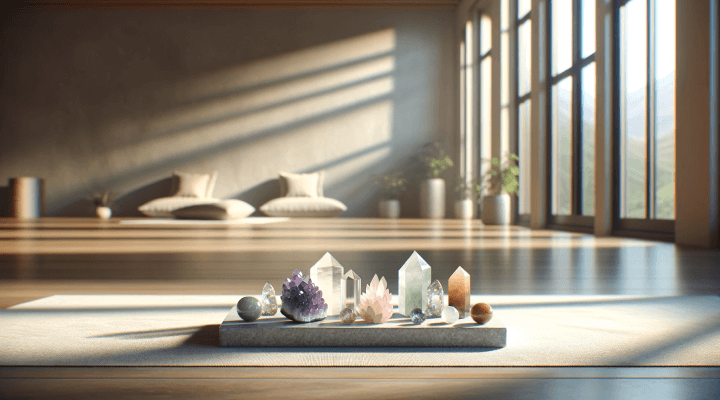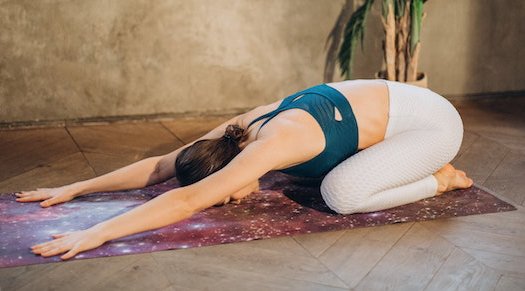“Find serenity and nurturing in Balasana, as you surrender to the earth and cradle your soul with love and tenderness.” Childs Pose Balasana
Child’s Pose, known as Balasana in Sanskrit, is a foundational yoga posture perfectly suited for beginners. It is a gentle and restful asana where one kneels with the knees wide apart, sitting back on the heels and reaching the arms forward to the mat. This soothing pose provides a sense of relaxation and is often used as a resting position in yoga practice.
Balasana is celebrated for its simplicity and its ability to release tension in the back, neck, and shoulders while promoting deep relaxation and introspection. Whether you are new to yoga or simply seeking a pose for moments of calm and centering, this comprehensive guide will introduce you to the basic techniques and alignment cues for Child’s Pose, allowing you to experience the physical and mental benefits it offers as a beginner practitioner.
Balasana Meaning
Balasana, commonly known as Child’s Pose, is a gentle and introspective yoga posture. The name “Balasana” is derived from Sanskrit, where “bala” means “child,” and “asana” refers to “pose” or “posture.” This asana involves kneeling on the mat, sitting back on the heels, and folding the upper body forward with the arms stretched out in front or alongside the body.
Balasana embodies a sense of surrender, nurturing, and returning to a childlike state of innocence and simplicity. It is often used as a resting or recovery pose in yoga practice, providing a moment of respite and introspection. This pose symbolizes the idea of seeking comfort and refuge within oneself, letting go of external worries, and finding solace in the present moment. Balasana encourages practitioners to release tension, both physically and mentally, and serves as a reminder of the importance of self-care and self-compassion on the yoga journey.
Benefits of Childs Pose Balasana
- Stretches the spine, shoulders, and upper back.
- Encourages deeper relaxation and lengthening of the spine.
- Provides a gentle stretch for the hips and thighs.
- Creates a forward fold that promotes relaxation and introspection.
Difficulty Level and Duration
Child’s Pose is considered a beginner-friendly posture, making it accessible to yoga practitioners of all levels. Its gentle nature makes it suitable for longer durations, ranging from 1 to 5 minutes or more. Listen to your body and adjust the duration according to your comfort.
How to do Childs Pose Balasana
Child’s Pose is a restful yoga pose that promotes relaxation and gently stretches the back, hips, and thighs. Follow these steps to practice Child’s Pose in its beginner variation:
- Starting Position: Begin by kneeling on your yoga mat with your big toes touching and knees hip-width apart. Sit back on your heels.
- Spine Alignment: Ensure that your spine is straight and your shoulders are relaxed. This is your initial kneeling position.
- Exhale and Fold Forward: As you exhale, slowly begin to hinge at your hips and lower your torso forward towards the mat.
- Arms Extended: Extend your arms forward on the mat, keeping them shoulder-width apart. Place your palms, forearms, or even your forehead on the mat, depending on your comfort level and flexibility.
- Forehead Resting: If your forehead is not on the mat, you can stack your fists or place a yoga block under your forehead for support.
- Hips Back: Sit back towards your heels as much as possible while maintaining comfort. This will help stretch your lower back and hips.
- Relaxation: Close your eyes and focus on your breath. Take slow, deep breaths, allowing your body to relax with each exhalation.
- Hold the Pose: Stay in Child’s Pose for as long as it feels comfortable, typically for 1-3 minutes or longer if desired. It’s a great pose for relaxation and calming the mind.
- Release the Pose: To exit Child’s Pose, gently walk your hands back towards your body, slowly sitting up on your heels.
Arms Alongside the Body

How to Perform
Begin in the same tabletop position as before.
As you sink your hips back toward your heels, keep your arms alongside your body, palms facing up.
Allow your forehead to rest on the mat, and relax your spine.
Breathe deeply and maintain the pose according to your comfort level.
Benefits
- Offers a more inward-focused experience by keeping the arms close to the body.
- Relieves tension in the shoulders and upper back without the stretch that comes from arms extended forward.
- Allows for a more compact, fetal-like position, promoting a sense of security and comfort.
- Offers a variation for individuals with wrist discomfort or limitations.
Choosing the Right Variation
The decision between arms extended and arms alongside depends on your intention for the pose and your body’s needs. If you’re seeking a gentle stretch and an opportunity for forward folding, the arms-extended version might be your preference. On the other hand, if you’re looking for a restorative and introspective variation that minimizes the stretch, arms alongside could be more suitable.
Whichever path you choose, may your journey through Balasana – the nurturing Child’s Pose – bring you the solace and rejuvenation you seek. Until our next exploration, embrace the beauty of choice on your self-care voyage.
Tips for Deeper Practise Childs Pose Balasana
For an enriched experience in Child’s Pose (Balasana), explore these tips to deepen your practice. Consider incorporating elements like yoga music, preparatory poses, alternatives, healing crystals, and a personal altar. These options can enhance your session, bringing a heightened sense of mindfulness and tranquility to your practice.
Preparation Poses Childs Pose Balasana
- Balasana Warm-Up: Before settling into Child’s Pose, it’s beneficial to start with a gentle warm-up. Begin in a tabletop position on your hands and knees. Take a few rounds of Cat-Cow Pose (Marjaryasana-Bitilasana) to mobilize your spine. This warm-up prepares your body for the deeper stretch of Child’s Pose.
- Wide-Legged Child’s Pose (Upavistha Balasana): If you find the traditional Child’s Pose too intense, you can practice the Wide-Legged Child’s Pose as a preparation. Start in a wide-knee position with your toes touching and knees apart. Extend your arms forward and lower your chest towards the floor, maintaining a gentle stretch.
Alternative Poses Childs Pose Balasana
- Downward-Facing Dog (Adho Mukha Svanasana): After performing Child’s Pose, transition into Downward-Facing Dog to stretch and strengthen your entire body. Start on your hands and knees, then lift your hips upward, forming an inverted V shape with your body. This pose provides a gentle inversion and a great full-body stretch.
- Cobra Pose (Bhujangasana) or Sphinx Pose: To counteract the forward folding nature of Child’s Pose and to extend the spine, practice Cobra Pose or Sphinx Pose. Lie on your stomach with your hands placed under your shoulders. Inhale and lift your chest off the ground, keeping your pelvis grounded.
- Seated Forward Bend (Paschimottanasana): Seated Forward Bend offers a counterbalance to Child’s Pose by stretching the back of the body, particularly the hamstrings and lower back. Sit with your legs extended in front of you, flex your feet, and hinge at your hips to reach for your toes while keeping your back straight.
Childs Pose Balasana with Yoga Music
Enhance your Child’s Pose (Balasana) experience with the soothing influence of Yoga Music during your yoga session. The calming melodies and rhythmic tunes create a peaceful ambiance, allowing you to fully relax and release tension in this restorative pose. As you gently fold into Child’s Pose and surrender to the soothing sounds, the right choice of yoga music can deepen your sense of serenity, reduce stress, and encourage a profound sense of inner calm. Whether you’re a beginner or an experienced yogi, incorporating yoga music into your Child’s Pose practice can make it a more peaceful and rejuvenating part of your yoga journey.
Crystal Healing with Childs Pose Balasana
Gemstones can enhance the experience of Child’s Pose (Balasana) by providing emotional support, balance, and empowerment. Incorporating these gemstones into your practice can help beginners deepen their connection with the physical and energetic aspects of the pose, supporting relaxation and intention during their yoga practice.

- Amethyst (or Rose Quartz): Amethyst promotes relaxation and inner peace in Child’s Pose, making it an ideal choice for beginners seeking comfort and serenity. Rose Quartz offers loving and soothing energy, enhancing the overall sense of calm during this restorative posture.
- Clear Quartz (or Selenite): Clear Quartz amplifies clarity and intention in Child’s Pose, assisting beginners in finding inner peace and focus during this calming posture. Selenite also supports mental clarity and energetic alignment, enhancing the meditative aspect of the pose.
- Lepidolite (or Howlite): Lepidolite offers soothing and calming energy, assisting beginners in finding relaxation and serenity in Child’s Pose. Howlite also promotes serenity and inner peace, supporting a restful practice.
- Green Aventurine (or Amazonite): Green Aventurine encourages heart-centered alignment in Child’s Pose, helping beginners connect with their inner strength and peace. Amazonite promotes balance, open communication, and a sense of inner harmony within the pose.
- Citrine (or Sunstone): Citrine boosts energy and motivation, empowering beginners to find strength and revitalization during Child’s Pose. Sunstone provides a similar invigorating influence for enhanced empowerment during relaxation.
Final Thoughts
As you explore the world of Balasana variations, remember that yoga is a personal journey. Whether you extend your arms forward or keep them alongside your body, both variations offer unique benefits. Listen to your body, honor your comfort level, and choose the variation that aligns with your goals for the practice.


